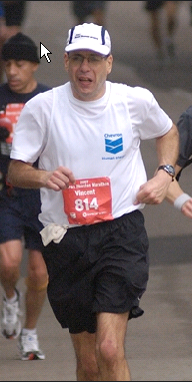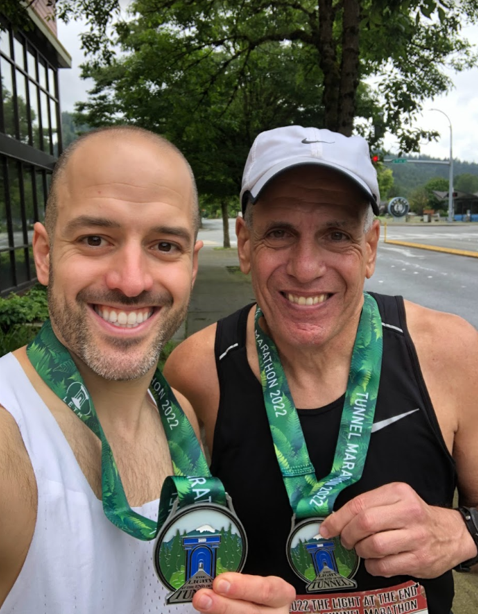The running journey started long times past with modest goals. Simply to run every day and begin to see the benefits of stronger legs, to run back-to-back basketball games with the young guys. Of course, at the start it was a challenge; and then you surprise yourself as your weight drops and your lungs expand a bit. Or so it seems*.
I learned that fitness adaptations can improve performance for up to seven years after the start of a training regimen. And so, my racing personal records fell one by one, over all distances, and it was a fine feeling. There is a science to all of this, yet in practice I learned how to improve by the feel of the runs, and it served me well for many years. My personal training manual read like this; “run as many miles as you can each week, as fast as you can run them, up to the point of injury or losing your job or being thrown out of your house.” The plan seemed to work. Often in those early years I would return from a run and proclaim that I had achieved “a new level of fitness,” always with a smile on my face. And running with young son Mike, us the night runners out after dusk, “like jets in formation.” It always hurts, but a good hurt that you work through as you count off the miles, in training, or in a race.

I sprained an ankle or two in my first year of running; I told myself (and others) that those went away when my tendons and ligaments were strengthened, and in fact these small injuries seemed to dissipate over time. I loved searching for the red line in my training builds, those high mileage weeks, one after another after another, that pushed me close to injury, though never beyond. And then occasionally an injury caught up with me, transient but real. A sprained back that lingered, a foot tendon, sprained ribs (from a fall at mile 16 of a marathon), and then finally a serious case of sciatica that took six months to heal. And I ran through it all with high mileage and never looked back. My mantra: “It will get worse, or it will get better, and it usually gets better.”
And then gradually the fitness equation changed. At first, I told myself that it was my reluctance to race in oxygen depletion, I did not want to endure that pain race after race. Possibly this was true. My training and race pace began to slow, at first just a touch, and then inexorably, as I faced the fact that I could never quite reach back to reclaim those PRs. I could still compete, but not against my former self. In the first year of the pandemic, I joined in with a couple of groups for long mileage virtual races. And I ran a lot, double digit mileage most days, though slower in pace than in years past. Time equals distance divided by pace and these runs were taking longer to run, or the distance was shortened to accommodate my schedule. I was beginning to run up a steeper hill.
As the years progress, my stride has shortened, my maximum heart rate has declined, soft tissue injuries have begun to mount up. Overuse arrives more frequently, initially a rolled ankle, then a foot tendon, then a sprained knee, all within a years’ time. I could take a week or two off, but I will not do that (after 21 years of running each day), and so I have reluctantly cut my mileage back, though never quite enough. Now it is a glute / hamstring / nerve issue, who really knows for sure. And so, the hill steepens a bit more. Now I must also guard against slow training runs, day upon day, because running fast seems to hurt.


But I do not mind, I can still compete against my current self. Pace is a constant companion. Though only to a degree of comparison. There is some beauty in a hard morning of exertion, pushing myself harder or simply enjoying the effort of the day. It is glorious in the moment; hold on to that.
As the author George Sheehan once wrote, “It is very hard in the beginning to understand that the whole idea is not to beat the other runners. Eventually you learn that the competition is
against the little voice inside you that wants you to quit.”
And: “Why do I run? We know that the effects of training are temporary. I cannot put fitness in the bank. If inactive, I will detrain in even less time than it took me to get in shape. And since my entire persona is influenced by my running program, I must be constantly in training. …Running has made this new me. Taken the raw material and honed it and delivered it back ready to do the work of a human being. I run so I do not lose the me I was yesterday and the me I might become tomorrow.” …..“I am a lonely figure when I run the roads. People wonder how far I have come, how far I have to go. They see me alone and friendless on a journey that has no visible beginning or end. I appear isolated and vulnerable, a homeless creature. It is all they can do to keep from stopping the car and asking if they can take me wherever I’m going.

Wise words to run by, and quoting myself: “Some days are better than others, but every day is a good day to run…”
…………….
*Training results in an increase in the efficiency of oxygen transport within the body. By lowering the resting heart rate (HR), and the HR at sub maximal loads, the heart pumps more blood with every heartbeat. This, in addition to other physiological changes, increases the oxygen extraction capability. This is the textbook description, but in you can feel the effects in everyday life.